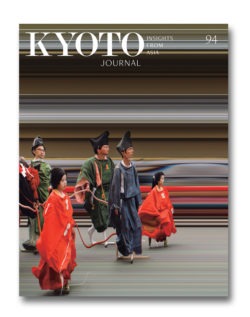Page Contents
It was an entirely non-Japanese source, composer Gustav Mahler, who said it best: Tradition is not the worship of ashes, but the preservation of fire. We most faithfully serve the heritage and legacy of an art form by cultivating a deep understanding of it, then thoughtfully reinterpreting what it means to our own time and place.
If that fire to be preserved happens to be the teaching of the tradition of the Japanese garden for learners and gardens outside of Japan, it is a bold and daring ambition. Setting out to share with gardeners outside of Japan the skills, knowledge, techniques and philosophies that have resided mainly in the hands and hearts of Japanese gardeners for centuries is a provocative undertaking. But it’s one that’s taking root at the Portland Japanese Garden with its Waza to Kokoro: Hands and Heart intensive training seminar in Japanese garden arts. Taught by Garden staff with visiting instructors from Japan, the three-level seminar is the flagship program of the Garden’s International Japanese Training Center and the first of its kind outside of Japan.
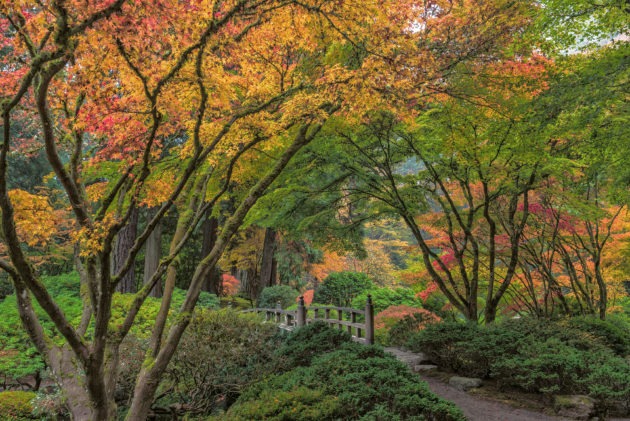
Moon Bridge surrounded by fall color
Born to teach
The Training Center and its seminar series are new, but the Portland Japanese Garden has always been a natural teacher – and its lessons have never been just about setting stones or pruning maples. Designed in 1963 under the supervision of Professor Takuma Tono of Tokyo Agricultural University, the Garden now encompasses 12 acres with eight separate garden styles that include a tea garden, a strolling pond garden, and a natural garden. Education has always been central to the Garden’s mission. Having a range of styles in one garden space is not typical in Japan, but it gives visitors a powerful sense of the history and forms of the Japanese garden. The Garden’s new Cultural Village — a complex of Kengo Kuma-designed buildings around a courtyard unveiled in 2017 – offers visitors experiences in traditional Japanese arts.
The Garden came to life at a time when memories of World War II lay fresh and raw on both sides. Its first director, Kinya Hira, can still recall the anti-Japanese rage that met the garden’s original builders – and how the garden’s emergent beauty melted that rage to stand as a living lesson about peace, forgiveness and the courage to accept a former enemy’s culture. The Garden’s new expansion, too, is rooted in a commitment to education, representing new lessons reflecting contemporary ecological concerns.
One prominent new feature is a dry stone creek bed designed by Garden Curator Sadafumi Uchiyama that runs down the Garden’s hillside channeling and filtering all storm water runoff. It meets new municipal regulations while at the same time providing a beautiful and striking entrance experience for visitors. It’s a perfect example of tradition serving as green infrastructure to meet modern ecological need in a place far from its origins. Portland itself offers an especially suitable location for such an endeavor, given to the Pacific Northwest city’s reputation as an environmentally-conscious, forward-thinking place rich with public gardens, parks and nearby natural landscapes ranging from mountains to Pacific coast to high desert.
The vision to create a training center with an intensive professional seminar in Japanese garden arts as its focal program is, too, a natural evolution of the Garden’s educational mission. It originates from years of thoughtful planning by Uchiyama, Curator Emerita Diane Durston, the Garden’s leadership and an international advisory council of practitioners and academics.
The Center launched in 2016 with the first Waza to Kokoro seminar. Now taking place twice a year, the seminar attracts staff from Japanese gardens outside of Japan but also welcomes professionals from landscape architecture, landscape design, horticulture, arboriculture, stonemasonry, and landscape construction.
Waza to Kokoro’s curriculum is centered on the traditional, hands-on learning process of stonework in the tea garden. This is complemented by theoretical instruction and practice in design, pruning, bamboo fence construction, aesthetics, history, and traditional tool use – all framed eloquently in the Philosophy of Tea. Technical skills gain context from connected cultural practices to nurture a sense of aesthetics, balance, and composition. Eastern and western learning traditions are intertwined, with observation and hands-on practice combining with lectures, workshops, and clinics for an immersive learning experience in Japanese garden arts.
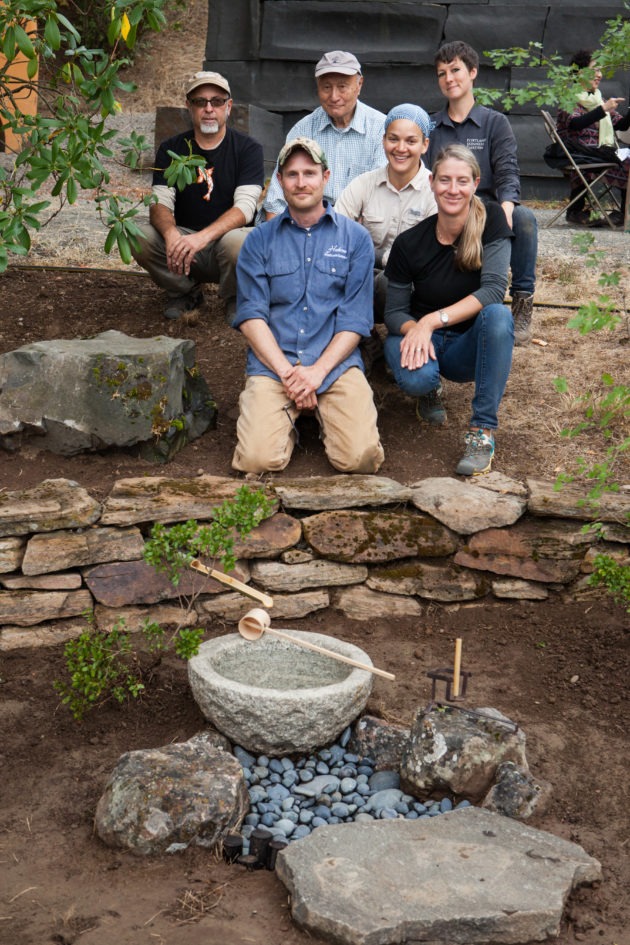
Kazuo Mitsuhashi’s group with their finished work
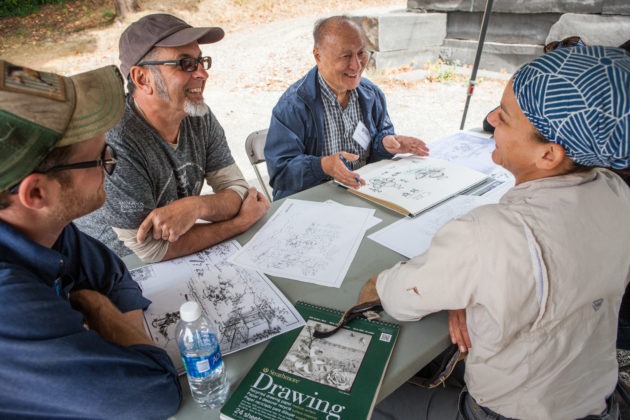
Mitsuhashi teaching
Japanese gardens are “a piece of nature that belongs very much in an urban lifestyle,” said Durston, who teaches Japanese aesthetics in the seminar. “If we can bring these two worlds together to create more gardens and keep the gardens that do exist as tranquil spaces in urban environments, that’s a great accomplishment. To see the Japanese masters come together with gardeners here and inspire each other has been tremendous to witness.”
Now in its fourth year with 57 participants to date from five countries, Waza to Kokoro is predicated upon fourth-generation gardener and U.S.-trained landscape architect Uchiyama’s belief that the skills, techniques and thought process central to Japanese gardening can be taught outside of Japan.
Thinking like a Japanese gardener
The seminar’s curriculum and philosophy can spark philosophical discussion on what’s Japanese and just how the art of the Japanese garden can be credibly taught to practitioners outside of Japan. Little learning material is readily available in English, and even in Japan much of traditional garden craftsmanship is gained through apprenticeship and not institutes of higher learning. Fundamental to the program are the twin pillars of authenticity and adaptation: staying true to the spirit and the tradition while acknowledging the context of here and now. It’s the idea that one who truly understands the essence knows how to modify it without diluting or corrupting it, like a jazz master who learns the intricacies of the rules and knows when to break them in just the right way. One of the core ideas of the seminar is that what makes a garden Japanese is not the provenance of the plants or whether it contains stone lanterns, bamboo fences or other iconic elements. It’s the aesthetic and the spirit behind how the garden is created, and even more important, how it’s treated over generations and even lifetimes. This is true for a Japanese garden whether it’s in Japan, Oregon, Brazil, France, South Africa – anywhere. What ultimately matters is the garden’s fostering – a word used by one of the seminar’s visiting instructors, Dr. Tomoki Kato, to underscore that we need to elevate how we think of the task of caring for the garden.
“Sometimes, the amount of devotion and passion we poured into the garden and received from the garden’s birth is all but forgotten and we just do simple maintenance work to keep present conditions. We forget the passion we once had for the garden,” said Kato, a faculty member at the Kyoto University of Art and Design and the eighth generation head of Ueyakato Landscape Ltd. of Kyoto. He added that it is important to “pour care, passion and love continuously into the garden as though it has just been born.”
Use of non-Japanese plants in a Japanese-style garden doesn’t detract from authenticity, added Takeshi Kato, one of Tomoki Kato’s staff and also a seminar instructor. “Thinking like a Japanese gardener, practicing the composition of Japanese garden design, applying what has been practiced, and consistent fostering of the garden are what keep the authenticity.”
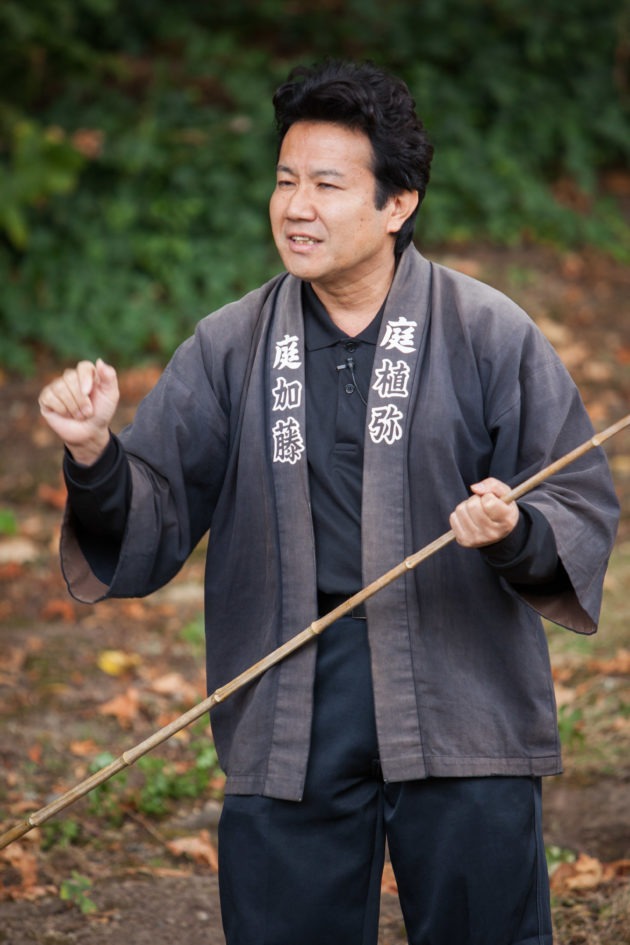
Kato teaching
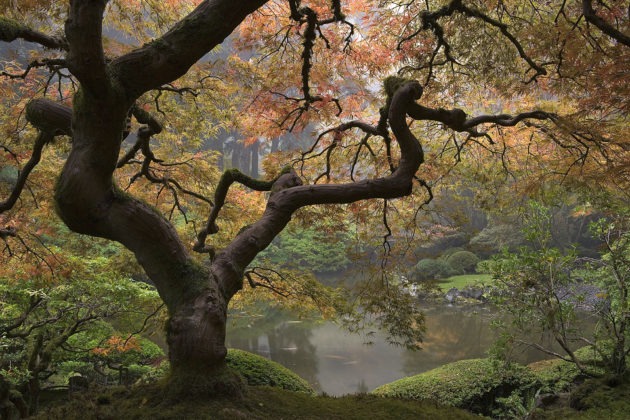
Japanese maple and upper pond in fall color
Tea is nought but this
On the first day of the seminar, tea instructor Jan Waldmann, Sosui – a Portland-based tea instructor with nearly 50 years of study of the Urasenke style of tea – demonstrates and explains traditional chanoyu in Kashintei, the Garden’s teahouse. But the next time participants see her, she’s making morning tea in a sumptuously rustic room at Smith Rock Inc., the Portland stoneyard where the seminar’s stonesetting workshop takes place. It’s not a tea house, it’s not formal, and it’s not Japanese. But it’s a place of honest, rugged, hardworking beauty, crafted from salvaged barnwood, stone, iron, and other materials that are the very embodiment of wabi loveliness. It is the perfect setting for the discussions Waldmann leads participants in on topics like wa-kei-sei-jaku — harmony, respect, purity and tranquility, the four spirits of tea – and their connection to the gardener’s work. It is also the perfect representation of the idea that we can respect and keep the essence of a tradition in a new place and time.
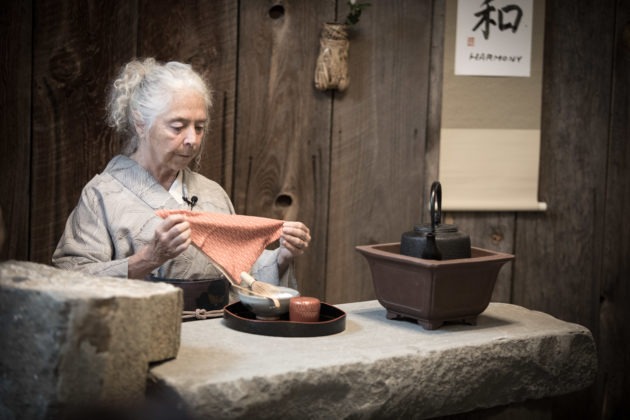
Tea ceremony with Jan Waldmann
And while Waldmann shares with participants her formidable knowledge of the Philosophy of Tea, she might tell a story from the life of Sen no Rikyu but could just as easily bring in a quote from Frank Zappa to explain the Philosophy of Tea. A poised and graceful style and a cultivated ability to share complex and nuanced information in an affable, welcoming way means that seminar participants – some of whom have little or no experience in tea – can embrace the art form with confidence and stay curious to learn more. Lunch, too, is an integral part of the scope of study, with short discussions on topics like seasonality and the culture of rice taking place over the exquisite compositions of meals provided by Portland’s Naoko Tamura. Chef Naoko is a local favorite whose radiantly healthy cuisine melds traditional Japanese recipes with local Oregon ingredients. As to the question of why the seminar is framed in Chado, the Way of Tea — why this particular art form over others? – instructor Kazuo Mitsuhashi offers an elegant answer.
“All design philosophies and skills are derived from the art of the tea ceremony,” said Mitsuhashi, a Tokyo-based garden craftsman and board member of the Garden Society of Japan. Mitsuhashi, — who studied with 20th century masters Isao Yoshikawa, Kenzo Ogata, and Sentaro Iwaki — said that tea as a practice “provides fundamental understanding for any art form such as painting and architecture. Understanding the art of gardening is no different. We were taught that if you do not understand the art of the tea ceremony, you won’t understand the art of gardening. Understanding kokoro from the spirit of the tea practice, to learn respect, harmony, and understanding the spirit of omotenashi is mandatory. This is the core of gardening.”
For these reasons, the Way of Tea is integrated into the curriculum so that garden practitioners can feel its connection to their professional work.
“I realized that the Japanese garden and more specifically the tea ceremony within that garden was an expression of human dignity and mutual respect between the people called to participate in the ritual,” said participant Lynn Wolfstone, a Portland landscape designer who completed the intermediate-level course in 2018. “The garden exists as an idealized universe that sets the tone for the participants and is an essential piece in supporting each guest in this experience. Having seen the possibilities of respectful interaction within the ceremony, one cannot help but be inspired to recreate that environment.”
And as it has been since the Portland Japanese Garden’s first days as a teacher of peace and tolerance, so it continues more than half a century later. The lessons are not only about setting stone, building bamboo fences, and pruning. They’re about cultivating a mindset, a philosophy, a way of seeing and doing and understanding.
“Mitsuhashi-sensei told me you can never build a garden better than you are,” said Tim Gruner, garden curator and head of horticulture for Anderson Japanese Gardens in Rockford, Illinois, who completed the intermediate-level seminar in 2016 after nearly 30 years’ experience as a gardener. “That really resonated with me. In North America we are now building our own Japanese-style garden tradition, with young people learning from experienced gardeners, transferring knowledge from one generation to the next just as in Japan.”
Gruner said that participating in the seminar gave him “ideas that have meant a lot to me as I navigate the responsibility of caring for a living work of art that connects so many people with the timeless beauty of ever-changing nature in an increasingly disconnected world. As Dr. Kato told us, no matter how hard we try we cannot achieve nature’s beauty. But, if we understand the depth of nature, we can weave in a human essence to create a beautiful garden. There has been a garden tradition in Kyoto for over a thousand years. There is another 1000 years to come. We must plant the seeds, and they can be planted outside of Japan, too.”
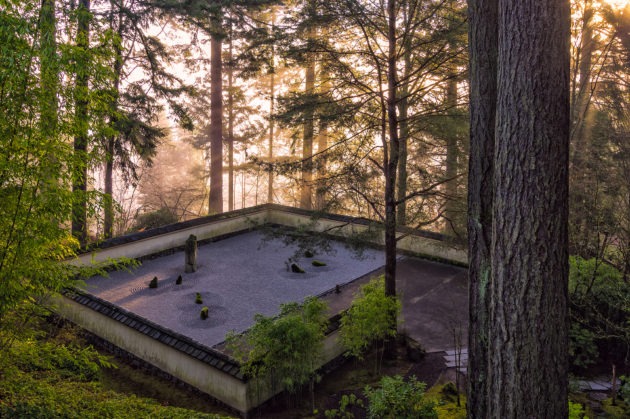
Overlooking the sand and stone garden in the morning
This year’s seminars take place on June 3-9 (beginner level) and September 16-27 (intermediate). The Waza to Kokoro seminar is presented by the International Japanese Garden Training Center, which offers learners of all levels the opportunity to gain a deeper understanding of the Japanese garden. Through a variety of educational programs, the Center teaches traditional skills and techniques for creating and fostering Japanese gardens — while acquainting learners with the garden’s cultural heart and soul. Visiting and permanent faculty include Portland Japanese Garden staff and practitioners, designers, and academics from the U.S., Japan, and other countries. The only such program in the world outside of Japan, the Center is a recipient of a 2018 Program of Excellence Award from the American Public Gardens Association and is supported by the Japan Foundation Center for Global Partnership. Other programs of the Center include:
- Garden workshops in bamboo, pruning and other topics designed for amateur enthusiasts
- A three-day design intensive for landscape professionals
- The Garden+ Public Lecture series, with speakers such as Marc Keane, Pico Iyer and Sou Fujimoto
- Haiku Alive, a poetry-based outreach program for underserved elementary-school students
www. japanesegarden.org/thecenter
This story was featured in: KJ94: Inspired by Kyoto


